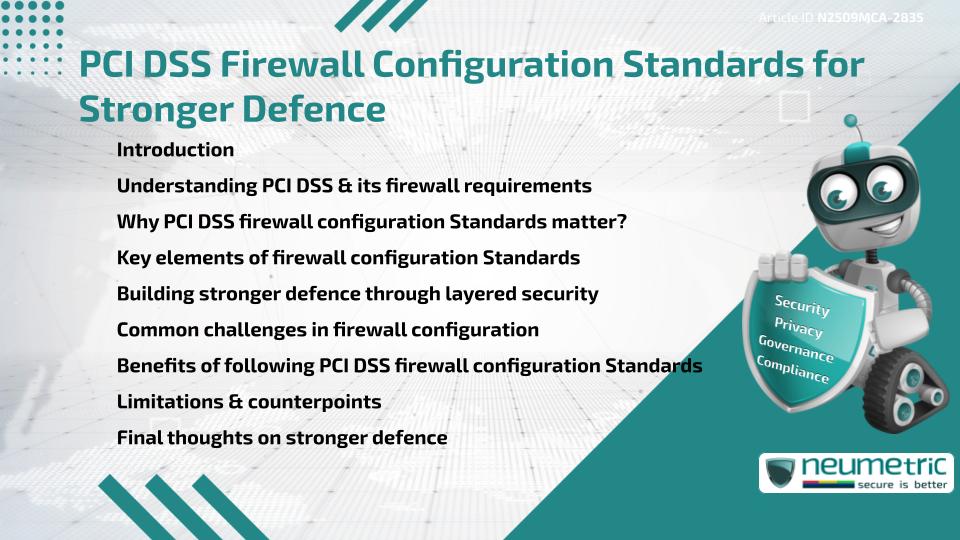Table of Contents
ToggleIntroduction
The PCI DSS firewall configuration Standards provide organisations with clear requirements to secure networks & protect Cardholder Data. As part of the Payment Card Industry Data Security Standard [PCI DSS], these configuration Standards ensure firewalls are properly designed, maintained & monitored. By implementing them, businesses reduce the Risk of unauthorised access, improve Regulatory Compliance & build stronger defences against Cyber Threats. This article explores the importance, key elements, challenges & benefits of applying firewall configuration Standards in line with PCI DSS.
Understanding PCI DSS & its firewall requirements
PCI DSS is a globally recognised Framework that outlines security requirements for organisations handling payment card data. Firewalls form the foundation of network security under this Framework.
The PCI DSS firewall configuration Standards are specifically designed to:
- Control incoming & outgoing traffic.
- Restrict access to Sensitive Data environments.
- Segregate public networks from internal systems.
- Enforce least privilege principles.
Think of firewalls as the security gates of a fortress. Without proper design, the gates may remain open or poorly guarded, exposing the entire system to attack.
Why PCI DSS firewall configuration Standards matter?
Firewalls are often the first line of defence against malicious activity. Poorly configured firewalls can create gaps that attackers exploit, leading to breaches of Cardholder Data. By enforcing PCI DSS firewall configuration Standards, organisations can:
- Prevent unauthorised access to sensitive systems.
- Reduce Risks of data leakage.
- Ensure consistent security across networks.
- Meet compliance obligations & avoid penalties.
In today’s interconnected environment, even a small misconfiguration can have major consequences.
Key elements of firewall configuration Standards
The PCI DSS firewall configuration Standards outline several critical elements, including:
- Documentation: Maintaining detailed network diagrams & firewall rules.
- Segmentation: Isolating Cardholder Data environments from other systems.
- Rule management: Reviewing & updating firewall rules regularly.
- Change control: Documenting & approving modifications to configurations.
- Logging & monitoring: Tracking all traffic & alerts for suspicious activity.
- Testing: Conducting regular reviews to validate firewall effectiveness.
Together, these elements form a continuous cycle of protection & improvement.
Building stronger defence through layered security
While firewalls play a vital role, they should not be the sole defence mechanism. Stronger defence comes from layering controls such as intrusion detection systems, Vulnerability management & Access Control.
Imagine a castle not only with gates but also with watchtowers, walls & guards. Firewalls are essential, but true defence comes from multiple protective layers working together.
Common challenges in firewall configuration
Implementing PCI DSS firewall configuration Standards can be challenging. Common issues include:
- Complex rulesets: Large organisations may struggle to manage extensive firewall rules.
- Human error: Misconfigurations often occur due to oversight.
- Resource limitations: Continuous Monitoring & testing require dedicated staff.
- Evolving Threats: Attackers constantly develop methods to bypass firewall protections.
Overcoming these challenges requires automation, training & regular Audits to maintain strong defences.
Benefits of following PCI DSS firewall configuration Standards
The advantages of applying these Standards are significant:
- Stronger protection of Cardholder Data.
- Reduced Likelihood of costly breaches.
- Improved compliance & reduced regulatory Risk.
- Greater trust with Customers & partners.
- Enhanced ability to detect & respond to Threats quickly.
Compliance with the Standards is not just about avoiding fines but also about safeguarding reputation & building resilience.
Limitations & counterpoints
Despite their importance, firewalls alone cannot guarantee total security. Attackers may exploit Vulnerabilities elsewhere, such as unpatched systems or weak User credentials.
Additionally, small organisations may find compliance resource-intensive, requiring investment in staff & tools. However, these costs are outweighed by the Financial & reputational damage of a breach.
Final thoughts on stronger defence
The PCI DSS firewall configuration Standards are essential for protecting Cardholder Data & strengthening network security. By following these requirements, organisations can build stronger defences, ensure compliance & foster trust with Stakeholders. Firewalls, combined with layered Security Measures, create a resilient environment against modern Cyber Threats.
Takeaways
- PCI DSS defines clear firewall configuration Standards to protect Cardholder Data.
- Firewalls serve as the first line of defence against unauthorised access.
- Standards require documentation, segmentation, rule management & testing.
- Challenges include complexity, human error & evolving Threats.
- Stronger defence comes from combining firewalls with layered security.
FAQ
What are PCI DSS firewall configuration Standards?
They are requirements under PCI DSS for designing, maintaining & monitoring firewalls to protect Cardholder Data.
Why are firewalls important in PCI DSS?
Firewalls act as barriers that restrict traffic & protect sensitive systems from unauthorised access.
What elements are included in firewall configuration Standards?
Key elements include documentation, segmentation, rule management, change control, monitoring & testing.
Do firewalls alone ensure compliance with PCI DSS?
No, firewalls are one requirement among many. Compliance requires multiple layers of Security Controls.
What challenges do organisations face with firewall Standards?
Challenges include managing complex rules, preventing misconfigurations, addressing resource limitations & adapting to evolving Threats.
How often should firewall rules be reviewed?
Firewall rules should be reviewed regularly, typically every six (6) months, to ensure effectiveness & compliance.
Can small organisations meet PCI DSS firewall configuration Standards?
Yes, although resource constraints may pose challenges, smaller organisations can implement tailored practices to meet the requirements.
Need help for Security, Privacy, Governance & VAPT?
Neumetric provides organisations the necessary help to achieve their Cybersecurity, Compliance, Governance, Privacy, Certifications & Pentesting needs.
Organisations & Businesses, specifically those which provide SaaS & AI Solutions in the Fintech, BFSI & other regulated sectors, usually need a Cybersecurity Partner for meeting & maintaining the ongoing Security & Privacy needs & requirements of their Enterprise Clients & Privacy conscious Customers.
SOC 2, ISO 27001, ISO 42001, NIST, HIPAA, HECVAT, EU GDPR are some of the Frameworks that are served by Fusion – a SaaS, multimodular, multitenant, centralised, automated, Cybersecurity & Compliance Management system.
Neumetric also provides Expert Services for technical security which covers VAPT for Web Applications, APIs, iOS & Android Mobile Apps, Security Testing for AWS & other Cloud Environments & Cloud Infrastructure & other similar scopes.
Reach out to us by Email or filling out the Contact Form…





